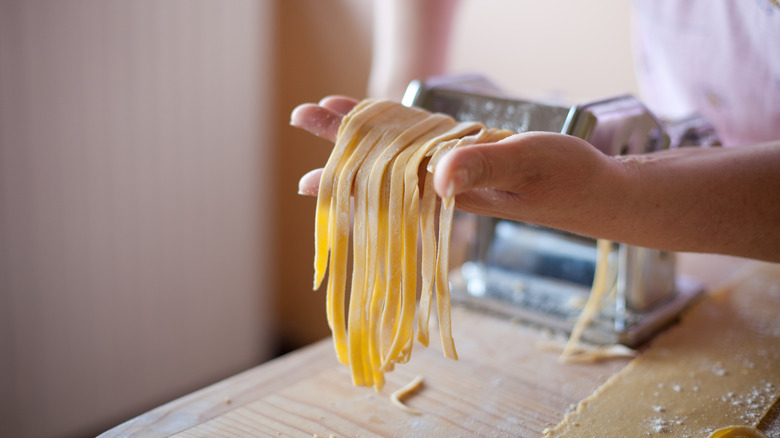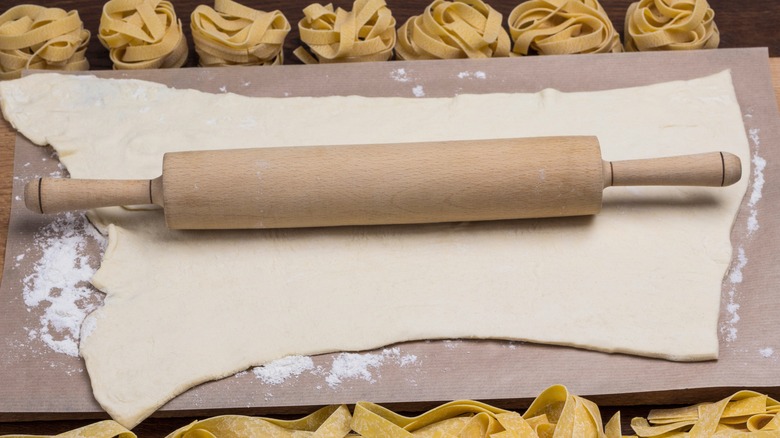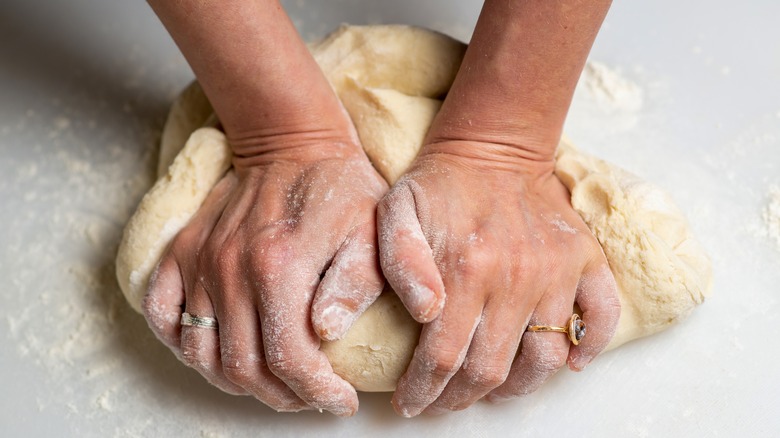This Is Why Your Homemade Pasta Isn't Cutting Properly
There's no reason to be intimidated by making homemade pasta. Yes, there are pasta machines and gadgets galore to make the job easier, not to mention tons of articles and cookbooks, but ultimately making pasta is a very simple process using only a few common ingredients. It's not entirely foolproof, of course, especially when it comes time to cut the pasta into noodles or other shapes. If you find that your fresh homemade pasta dough isn't cutting properly, it's most likely still too wet and you need to slow down before moving to the next step. All you have to do is wait about 15 minutes after rolling out the dough and you should be able to get much more precise cuts.
People have been making pasta for hundreds of years with just their hands, a clean surface, and a rolling pin, so don't get swept up in shopping for tools and gadgets if you're learning to make pasta at home. The only skills any pasta maker needs are patience and timing — and perhaps a really good recipe for Italian tomato sauce — to nail it.
Let the surface of the dough dry before cutting
Humans have been making pasta since around 1100 B.C., but it wasn't until the ninth or 10th centuries that humans started cutting the dough into noodles. That's because up until then pasta was mostly made with soft varieties of wheat, which in turn made soft dough that was rolled out into sheets. It wasn't until we figured out how to cultivate durum wheat, which makes drier, stiffer dough, that noodles came into creation. Keep this in mind today, because if you want noodles or shapes, your pasta dough can't be too soft or wet.
After any pasta dough is mixed together, kneaded, rested, and rolled out, the surface of the dough will still be slightly wet and tacky. While the kneading process helps the flour absorb a lot of the moisture in the dough, even if the surface feels dry to your touch it's important to wait for about 15 minutes before you do any cutting. That amount of time will allow the surface of the pasta to dry without the inside of the pasta becoming too brittle. This is key so that you can roll the sheets up to cut long noodles without it all sticking together (too wet) or breaking apart (too dry).
Make sure the dough isn't too wet
If you're still having trouble cutting pasta sheets after waiting 15 minutes, the problem might be that the dough itself is just too wet. Sometimes you won't realize that your dough is too wet until it's already rolled out, especially because wetter dough is easier to knead, but it's actually simple to spot the signs of wet dough way before any rolling starts.
Watch what's going on in the bowl carefully for the first few minutes of kneading the dough, whether you're doing it by hand, in a mixer, or in the food processor like Bobby Flay. The goal is to create a ball of dough that doesn't stick to the sides of the bowl or your hands. If the dough is sticking to everything after the first three or four minutes of kneading, it's too wet. If this is the case, add a tablespoon of flour to the bowl, knead for another three to four minutes, and repeat the process as necessary. You don't want to add too much flour too fast and end up with dough that's too dry, either, so take it slow. Remember, making homemade pasta is all about patience and timing. Give the dough enough time for kneading, resting, and drying and you'll have no trouble cutting up perfect linguini and pappardelle every time.


